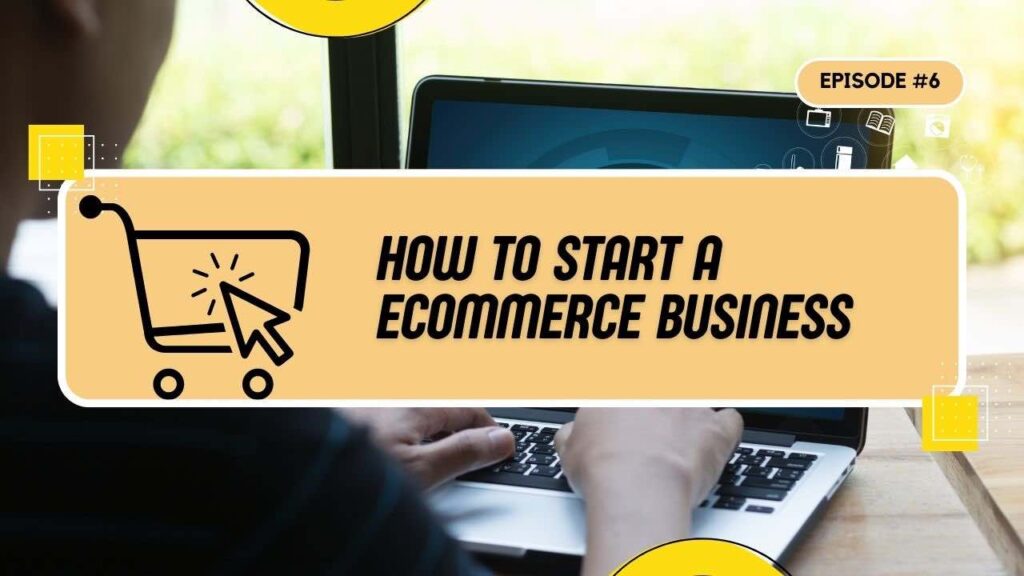
Do you have the intention of creating the next groundbreaking online marketplace that will rival the likes of Amazon, eBay, Alibaba, Jumia, Konga, and similar platforms? If so, welcome to the world of e-commerce also known as e-business.
This business venture allows beginners and starters to operate from the comfort of their own homes, presenting an exciting journey with a level playing field for both new and established competitors to thrive.
In today’s interconnected world, starting an ecommerce business has become an increasingly popular and lucrative venture. With the right strategy, dedication, and a sprinkle of creativity, you can transform your passion into a thriving online store that attracts customers from around the globe.
The beauty of e-commerce is that it has an endless potential to accommodate every industry be it a fashion designer, a tech enthusiast, or an expert in crafts, the online marketplace provides an equal opportunity for you to showcase your products and connect with a vast customer base.
In this article, we will not only be talking about, how to start a ecommerce business, but also the intricacies of running a successful online store.
Table of Contents
What does ecommerce mean?

Electronic commerce which is popularly known as Ecommerce, refers to the buying and selling of goods or services online without physical involvement in the transaction process until the delivery of the item.
Ecommerce facilitates online transactions for products or services between businesses (B2B), businesses and consumers (B2C) which is the most successful type of ecommerce, or consumers themselves (C2C).
Ecommerce eliminates the requirement for physical stores or face-to-face interactions, enabling people to conveniently and securely engage in commercial activities through online platforms.
It includes various activities such as, online shopping, online banking, electronic payments, online auctions, and digital content distribution.
Ecommerce has revolutionized the way businesses operate and consumers shop, offering a global marketplace with easy access, broad product selection, and convenient delivery options.
Is E-commerce profitable?

Yes, E-commerce has proven to be a highly profitable venture for many entrepreneurs and businesses. With the continuous growth of online retail, there is ample opportunity to generate substantial profits.
According to Insider Intelligence, e-commerce is projected to represent 24% of retail sales by 2026. This growth is fueled by various factors, such as the rise of mobile commerce (commerce), and the shifting demographics of online retail shoppers. These trends indicate a growing customer base and a wider reach for ecommerce businesses, creating a fertile ground for profitability.
Furthermore, it is important to note that profit margins in e-commerce can vary greatly depending on the types of products sold and the specific business strategies employed. While different industries and business models may yield varying profit margins, a 5% profit margin is still considered a decent return for many e-commerce entrepreneurs and businesses.
In fact, certain types of products, particularly those with a higher average selling price (ASP) exceeding $250, can often yield more profitability in the e-commerce business compared to traditional brick-and-mortar retail channels. This is due to reduced overhead costs, such as rent and staffing, associated with physical stores. By leveraging the scalability and cost-efficiency of ecommerce, businesses can maximize their profit potential.
How Return Rate of Products Affects Profitability in E-commerce Business

One aspect that e-commerce businesses need to consider is the issue of returns, particularly in categories like clothing and shoes.
The return rate for such products can range between 30% to 40%. It is crucial to factor in the costs associated with returns, as they can impact overall profitability. In fact, it is estimated that returns can cost retailers around 10% of their revenue.
In using a clothing retailer to illustrate how higher return rates in certain product categories, like clothing and shoes, can impact overall profitability.
Imagine you run an e-commerce store specializing in trendy clothing and footwear. While your products are highly sought after and attract a large customer base, the nature of the fashion industry means that returns are quite common. Studies have shown that return rates in this category can range from 30% to 40%.
Now, let’s consider the financial implications of these return rates on your business’s profitability. Suppose your online store generates $1 million in revenue over a specific period.
With a return rate of 30% and an average order value of $100, you can expect returns amounting to $300,000. Similarly, if your return rate reaches the higher end of 40%, returns would total $400,000.
These returns directly impact your revenue, as you will need to process refunds, handle returned items, and potentially bear associated shipping costs. In this scenario, assuming returns cost you 10% of your revenue, the costs would be $100,000 for a 30% return rate and $140,000 for a 40% return rate.
As you can see, the higher return rates in the clothing and shoes category can significantly impact your bottom line.
The costs associated with processing returns and the potential loss of revenue due to returned items can eat into your profits.
This is especially true when profit margins in the fashion industry tend to be relatively thin.
How to mitigate the impact of returns on profitability
To mitigate the impact of returns on profitability, clothing retailers can implement various strategies.
For instance, they can invest in accurate product descriptions, size charts, and images to reduce sizing-related returns.
Offering detailed product measurements, customer reviews, and styling tips can also help customers make informed purchasing decisions, potentially reducing the likelihood of returns.
Additionally, establishing a clear and customer-friendly return policy can provide a seamless and hassle-free return experience, encouraging customers to consider exchanges or store credits instead of full refunds.
By actively managing return rates and implementing strategies to minimize them, online clothing retailers can improve their overall profitability and maintain a healthy balance between customer satisfaction and financial success.
How much do I need to start ecommerce business?

You can start an e-commerce business with a minimum of $20,000 if you are going to be involved in the inventory management. But if you are going to be using a dropshipping business model, a minimum of $1,000 will do.
Though the amount of capital required to start an ecommerce business can vary significantly depending on various factors such as the scale of operations, the type of products you plan to sell, your target market, and your business strategy.
Here is a tabular breakdown of the most important cost of starting an e-commerce business.
| Item | Estimated Cost |
|---|---|
| Website Development and Design (Domain and Hosting inclusive) | $500 – $2,000 |
| Marketing and Advertising | $200 – $5,000+ |
| Technology and Software | $20 – $100+ per month |
| Integrated Payment Solution | Varies |
| Inventory, Product Sourcing and Manufacturing, Packaging, and Shipping (If it is not a dropshipping model) | Varies |
| Licenses and Permits | Varies (contact local authority) |
| Legal and Administrative Costs | Varies |
How To Start a Ecommerce Business

1. Identify Your Niche
When discussing the concept of identifying your niche in the context of starting an e-commerce business, we are referring to the process of discovering a particular market segment or specialized area within an industry that will be the main focus of your business.
It involves narrowing down your business’s scope to cater to a specific group of customers with distinct needs and preferences.
Here are the key aspects to consider when identifying your niche:
- Building a business around something you genuinely enjoy and have knowledge
- The business idea must have a substantial Market Demand
- You should be knowledgeable about your Target Audience
- Do a thorough analysis about your potential competitors
- Identify your product’s Unique Selling Points (USPs) (ie what sets your business apart from others in the market).
By identifying a niche that aligns with your interests, expertise, and market demand, you can position your e-commerce business for success.
2. Create a Business Plan
Prior to launching your e-commerce business, having a well-defined business plan is crucial. This plan acts as a guide for making daily decisions and provides a projection of the future of your business.
A business plan outlines your goals, strategies, and financial projections, which are essential for attracting investors and securing loans. It serves as a comprehensive document that covers key elements necessary for your business’s success.
Let’s delve into the key components that should be included in a business plan.
- Business Goals
- Target Market
- Brand Identity
- Product Sourcing Strategy
- Pricing Model
- Sales Projections
- Marketing and Customer Acquisition Strategies
- Customer Retention Strategies
- Financial Projections
Remember, a business plan is not set in stone and should be flexible to adapt to changing market conditions. Regularly review and update your plan as you gain more insights and experience in running your e-commerce business.
Read More: How to Write a Business Plan
3. Choose the Right E-commerce Platform
Selecting the appropriate e-commerce platform is a crucial decision when starting an ecommerce business. The platform you choose will serve as the fundamental infrastructure for your online store, overseeing essential functionalities including product listings, payments, inventory management, and customer interactions.
Some popular e-commerce platforms include Shopify, WooCommerce (a WordPress plugin), Magento, BigCommerce, and Squarespace Commerce.
Each of the platform has its unique strengths and caters to specific target audiences. It is important to conduct thorough research and compare these platforms based on your specific requirements and business goals.
To know the best e-commerce platform for your business, these factors must be adequately considered;
- Features:
Evaluate the features offered by different e-commerce platforms. Consider the capabilities you need for your business, such as flexible product management, customizable themes and designs, mobile responsiveness, SEO optimization, abandoned cart recovery, discounts and promotions, and integration with other tools and services. Make sure the platform provides the necessary features to support your business objectives.
- Scalability:
Consider the scalability of the e-commerce platform. Your business may grow over time, and you’ll want a platform that can accommodate increased traffic, higher order volumes, and additional product listings. Look for platforms that offer scalability options, such as the ability to handle high traffic loads, easy product catalog expansion, and seamless integration with third-party apps or plugins.
- Ease of Use:
Evaluate the user-friendliness of the platform. Seek a platform that provides a simple and intuitive interface, enabling effortless management of your store, seamless addition of products, and smooth order processing. A user-friendly platform minimizes the learning curve and empowers you to concentrate on expanding your business instead of grappling with technical complexities.
- Pricing:
Evaluate the pricing structure of the e-commerce platforms you’re considering. Different platforms offer various pricing plans, ranging from monthly subscriptions to transaction fees or a combination of both. Consider your budget and the value provided by each platform. Take into account not only the upfront costs but also any potential additional expenses for themes, plugins, or integrations.
- Integration and Customization:
Check if the e-commerce platform integrates seamlessly with essential tools and services. Consider your needs for payment gateways, shipping providers, inventory management systems, analytics tools, and email marketing platforms. Ensure that the platform allows for easy integration with these services, reducing manual tasks and streamlining your operations. Additionally, assess the level of customization the platform offers, allowing you to create a unique and branded store experience.
- Community and Support:
Conduct thorough research on the platform’s community and support resources. Seek an engaged user community, online forums, comprehensive documentation, and tutorials that can assist you in resolving issues or finding answers to your queries. Additionally, consider the availability of customer support options like live chat, email, or phone support to aid you when facing challenges or requiring technical assistance.
Please Note: During your researching for the best platform for your e-commerce business, don’t limit your search only on the popular e-commerce platforms as there are some extremely good non popular e-commerce platform out their that could be the perfect one for your business specification and affordability.
4. Choose Your Business Model:
The business model focuses on the method by which your e-commerce business will operate. It is possible to choose a business model at the startup stage of your e-commerce business, then swap or give room to accommodate another type of business model within time of business operation. But it is recommended to stick with one business model in other to keep the trust of your online customers.
Here are two key considerations in choosing the perfect business model for your e-commerce business:
1. Selling Your Own Products or Reselling/Dropshipping:
- Selling Your Own Products:
If you have exclusive products that you have created or obtained from sources, you have the option to sell them directly to customers. This grants you greater control over the quality, branding, and pricing of your products. However, it also entails the responsibility of managing inventory and fulfilling orders.
- Reselling/Dropshipping:
Another option is to consider becoming a reseller or engaging in dropshipping. Reselling entails buying products from suppliers or manufacturers at wholesale prices and selling them to customers at a higher price for profit. On the other hand, dropshipping involves collaborating with suppliers who take care of inventory storage and product shipment directly to customers. Both models eliminate the need for maintaining inventory, although dropshipping may result in less control over product quality and order fulfillment.
2. Marketplace Platform or Own Ecommerce Website:
- Marketplace Platform:
You can choose to sell your products on established marketplace platforms like Jiji, Jumia, Obiwezy, Konga, Amazon, PayPorte, Ajebomarket, Vconnect, eBay, Etsy, or any other online marketplace platform of your choice. These platforms provide built-in customer traffic, credibility, and logistical support. However, you’ll face competition and need to comply with their rules and fees.
- Own Ecommerce Website:
Building your own ecommerce website gives you more control and flexibility over branding, customer experience, and business operations. You can customize your website, develop a unique brand identity, and have complete control over product listings, pricing, and customer data. However, building and managing your website requires more technical knowledge and ongoing maintenance.
Note: Choosing your business model and platform relies on various factors, including your product offering, target market, desired level of control, budget, and long-term objectives.
There is an option some entrepreneurs opt for, which is a hybrid approach. They begin by utilizing a marketplace platform to enhance their visibility and subsequently expand to their own website as they progress.
It is crucial to thoroughly assess the advantages and disadvantages of each option, taking into account factors like costs, scalability, branding opportunities, operational control, and customer reach.
Ultimately, the most suitable decision will hinge on your unique business goals, available resources, and personal preferences.
5. Build Your Online Store
What is ecommerce business without an online store? That is how important an online store is in the e-commerce business. It involves creating a visually appealing, user-friendly, and secure website that effectively showcases your products or services.
When building an online store, certain components are considered key as they must be integrated to create a seamless and exceptional online shopping experience. These key components include:
- Visual Appeal and Brand Identity:
Craft a website that mirrors your brand identity by designing it in a way that resonates with your target audience. Employ consistent branding elements like colors, fonts, and imagery to establish a unified and memorable encounter for your visitors. Consider investing in professional web design services or leverage a reputable e-commerce platform offering customizable themes and templates that harmonize with your brand image.
- Mobile Optimization:
Ensure your online store is optimized for mobile devices, recognizing the growing trend of users accessing the internet and making purchases through smartphones and tablets. It is imperative to guarantee that your website is mobile-responsive, meaning its design and layout automatically adapt to various screen sizes. This ensures a smooth and effortless browsing and shopping experience for mobile users.
- Clear Product Organization:
Arrange your products into coherent categories and subcategories, prioritizing ease of navigation for your website visitors. Simplify the process of finding desired products by implementing filters, search functionality, and sorting options. These enhancements contribute to an improved user experience, enabling customers to swiftly locate specific items with convenience.
- Compelling Product Descriptions:
Write compelling and comprehensive product descriptions that effectively showcase the distinctive features, advantages, and value of each item. Utilize clear and concise language, emphasizing the customer benefits, while incorporating relevant keywords for search engine optimization (SEO) purposes. Consider incorporating storytelling techniques or customer testimonials to establish an emotional connection with your audience and foster trust in your brand.
- High-Quality Product Images:
Invest in high-quality product images that accurately represent your products. Use professional photography or high-resolution images that showcase different angles, details, and variations. Ensure that the images load quickly and are optimized for web display. Include zoom or hover-over features to allow customers to examine the products closely.
- Secure Payment Options:
Implement secure payment gateways to protect customer information and ensure a safe transaction process. Choose reputable payment providers that offer encryption and comply with industry security standards. Popular payment gateways include PayPal, Stripe, and Braintree. Display trust badges or security seals to reassure customers about the safety of their personal and financial data.
- Smooth Checkout Process:
Optimize the checkout process to reduce friction and minimize cart abandonment. Streamline the steps, ensuring they are clear, intuitive, and free from unnecessary distractions. Keep the form fields to a minimum, making it effortless for customers to complete their purchase. Offer multiple payment options, including credit cards, digital wallets, and installment plans, to cater to diverse customer preferences. Implement convenient features like guest checkout, auto-fill, and saved payment information to simplify the purchasing process for your customers.
Remember, the user experience is paramount when building your online store. Continuously optimize and refine your online store based on customer feedback and analytics insights to maximize conversions and customer satisfaction.
6. Legal Requirements
The legal requirement of your ecommerce business, covers from choosing a business name to meeting local regulations. Below are the steps required to meet the legal requirement of your e-commerce business;
Choose a Business Name and Register your business
Select a name that represents your business and aligns with your brand identity and has not been registered by another entity. The extra things you should also check out is the trademark; make sure the name has not been trademarked and lastly secure a corresponding domain name.
The next thing to do is to register your business name with the appropriate government agency responsible for business registrations. In Nigeria, the Corporate Affairs Commission (CAC) is the body in charge of that.
The registration process will involve filing registration forms, paying registration fees, and providing relevant information about your business.
It is recommended to register your e-commerce business as a Limited Liability Company (LLC) as it protects against personal liability.
Read More: How to Register a Business Name in Nigeria in 7 Easy Steps
7. Obtaining Licenses and Permits for Your eCommerce Business
When starting an eCommerce business in Nigeria, it is crucial to adhere to the legal and regulatory requirements. Securing the necessary licenses and permits is an essential step in ensuring your business operates within the legal framework.
Let’s explore some key considerations related to licenses and permits for your eCommerce venture in Nigeria.
- NITDA Registration:
Under the NITDA Act, it is compulsory for all companies or individuals engaging in eCommerce business to register with the Nigeria Information Technology Development Agency (NITDA), with a clause of “depending on the type of business”. NITDA plays a vital role in establishing the National Electronic Commerce Council (NECC), which governs all electronic commerce users and businesses in Nigeria. Registering with NITDA demonstrates compliance and allows you to benefit from their support and facilitation of international trade through eCommerce.
- Compliance with Tax Laws:
Comprehending and complying with tax laws is of utmost importance for eCommerce business owners. Stay updated on tax regulations, such as the Value Added Tax (VAT), company income taxes, and relevant laws in each country where buyers and sellers are located. The Federal Inland Revenue Service’s proposed introduction of the Online Purchase Tax further emphasizes the need for eCommerce businesses to be well-versed in tax obligations.
Consulting tax experts and knowledgeable tax lawyers in Nigeria is highly recommended to understand the mandatory taxes and their implications for your business. They can provide valuable insights and guidance to ensure compliance, mitigate risks, and avoid legal penalties.
Commercial Attorneys:
Engaging the services of commercial attorneys is essential for navigating the legal landscape associated with eCommerce business in Nigeria. Commercial attorneys can assist in handling registrations with statutory bodies and securing necessary approvals before commencing operations. They possess the expertise to guide you through the legal intricacies and help you establish your business in compliance with the law.
It is essential to conduct thorough research and consult with commercial attorneys who specialize in eCommerce and have a comprehensive understanding of the legal requirements specific to Nigeria. By partnering with knowledgeable professionals, you can navigate the licensing and permit process with confidence.
By registering your business and obtaining the necessary licenses and permits, you ensure that your ecommerce business operates legally and avoids potential penalties or legal issues in the future. Compliance with legal requirements also instills trust in customers and partners, contributing to the long-term success of your business.
8. Implement Customer Support and Policies
Setting up effective customer support channels and clear policies is a means to demonstrate your commitment to addressing customer needs and ensuring their satisfaction. This helps build trust, loyalty, and a positive brand reputation, ultimately contributing to the success and growth of your e-commerce business.
Here is how customer satisfaction can be attained through support and policies;
1. Set up Customer Support Channels:
- Email Support: Provide a dedicated email address where customers can reach out with inquiries, concerns, or feedback. Respond to customer emails promptly and professionally.
- Live Chat: Offer live chat support on your website to provide real-time assistance to customers. This can help address their questions or concerns quickly and efficiently.
- Phone Support: If feasible, offer a phone support option with a dedicated phone number for customers to reach your support team.
- Determine the customer support channels you want to offer, such as email, live chat, phone support, or a combination.
2. Develop Clear Policies:
- Returns and Refunds: Create a clear and easy-to-understand policy for product returns and refunds. Specify the conditions for returns, such as time limits, item condition, and refund methods. Communicate this policy on your website and ensure it aligns with local consumer protection laws.
- Shipping and Delivery: Outline your shipping and delivery policies, including information about shipping methods, delivery times, and any associated fees. Clearly communicate any limitations, restrictions, or potential delays.
- Customer Satisfaction: Establish a policy focused on customer satisfaction. Clearly articulate your commitment to addressing customer issues promptly and effectively. Provide guidelines for handling customer complaints or concerns and ensure a positive resolution process.
3. Train and Empower Customer Support Staff:
- If you have a dedicated customer support team, ensure they receive proper training on your products, policies, and best practices for customer service.
- Empower your customer support team to handle customer inquiries, concerns, and complaints with empathy, professionalism, and efficiency.
- Equip them with the necessary resources and tools to provide accurate and helpful responses to customers.
9. Secure Funding
If you find the financial burden overwhelming, you have the option to explore alternative sources of funding to alleviate the pressure. This funding acquisition can occur during the initial stage of launching your e-commerce business or during expansion in the global market by targeting additional countries. Whichever you choose to settle on, here is a list of potential funding sources for you to consider:
- Personal Savings
- Friends and Family
- Small Business Loans
- Crowdfunding
- Angel Investors
- Venture Capital
- Grants and Government Programs
- Bootstrapping
When seeking funding for your e-commerce business, it is of utmost importance to meticulously prepare a comprehensive business plan, financial projections, and a persuasive pitch. These materials should effectively convey the value proposition and growth potential of your venture to potential investors. By crafting a compelling presentation, you enhance your chances of securing the necessary funding for your e-commerce business.
KEY RESOURCES:
- How to Get a Loan to Start a Business from the Government
- Federal Government Loans for Small Business in Nigeria
- How to Get a Loan to Start a Business in 11 Steps
10. Implement Effective Marketing Strategies
Without an effective marketing strategy, your e-commerce business will remain unknown to potential customers. That’s why marketing your business is a deliberate act that must be pursued with clear marketing goals in mind.
Below are the best marketing strategies used by top e-commerce businesses to attract customers;
- Organic and Paid Channels; (Organic channels focus on building long-term visibility and brand awareness, while paid channels offer more immediate results).
- Social Media Marketing:
- Search Engine Optimization (SEO)
- Content Marketing
- Email Marketing
- Influencer Collaborations
- Paid Advertising AKA pay-per-click (PPC)
Remember to continuously monitor and analyze the performance of your marketing efforts. Use web analytics tools to track website traffic, conversion rates, and customer behavior. Adjust your marketing strategies based on the insights you gather, focusing on channels and tactics that deliver the best results.
Final Thoughts on Starting an e-commerce business
That is all about how to start a ecommerce business. let it be known that dedication, perseverance, and a readiness to learn and adapt are attributes you must have before you can succeed in the ecommerce business.
Remain updated on industry trends, be open to feedback, and embrace emerging technologies that can optimize your business operations.”
Remember to turn on the Bell 🔔 Notification icon to get updated on your device when new articles are published.
Discover more from StartBizEasy
Subscribe to get the latest posts to your email.





